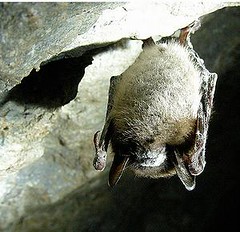 美國和加拿大的生物學家普遍認為,多達670萬隻蝙蝠是死於白鼻病。
美國和加拿大的生物學家普遍認為,多達670萬隻蝙蝠是死於白鼻病。
最新的蝙蝠死亡統計是由超過140部落或政府的生物學家、以及蝙蝠研究人員所認可,這些專家1月中旬在美國賓夕州的喀來耳郡聚集召開年度會議,當地也是嚴重遭受蝙蝠死亡影響的地區之一。
白鼻病已席捲北美地區的蝙蝠,在許多地區有高達百分之百的死亡率。在紐約2006年有資料記錄,該傳染病快速散播到美國16個州和4個加拿大省份。
生物學家們表示,他們認為這疾病會持續擴散。
美國漁業暨野生動物局局長Dan Ashe表示,「這個驚人的新數據顯示了白鼻病對蝙蝠造成嚴重的生命威脅,而且影響的範圍以演變成為我們國家的問題。由於蝙蝠可有效地防治美國農地和森林的害蟲,為美國的經濟有很大的貢獻,牠們可以防治那些會傳染疾病給人類的昆蟲。我們正密切地研究蝙蝠,去了解這個致命疾病的散播原因,盡量把疾病對蝙蝠的傷害減到最小。」
這是北美有史以來最嚴重的野生動物傳染病大爆發,讓許多環境學者認為許多飛行哺乳動物恐將瀕臨絕種。
「這些數字讓研究白鼻病一段時間的專家學者們,確認蝙蝠正以驚人的數量死亡,而且許多物種正快速地朝向滅亡的命運邁進。」生物多樣性研究中心的Mollie Matteson說到,她已發出多次請願來拯救蝙蝠並阻止白鼻病的散播。
美國國會日前已指示內政部撥款400萬美元給白鼻病研究管理中心,其中生物學家相信該疾病是由真菌類所造成。
Matteson表示,「美洲的蝙蝠正面臨史無前例的危機,而且其中有些種類可以說是接近滅絕。令人感到振奮的是,看到有款項分配要來解決白鼻病,現在新的死亡數據就是警告我們需要做更多,且更快速地來解決這問題。」
目前為止,白鼻病已影響到六個蝙蝠種類,使牠們在冬眠期時死亡,也就在牠們在洞穴和礦坑中懸掛的時候。
科學家估計,蝙蝠幫農民節省用在玉米、棉花、蔬果等作物上的殺蟲劑費用,約在37億到530億美元之間。
由於蝙蝠傳染病兩年前才開始出現在美國中西部和南部,這些區域比東北各州更依賴農業生產,蝙蝠數量減少的整體影響可能要在一段時間後才會顯現。
As many as 6.7 million bats have now died from white-nose syndrome, biologists from across the United States and Canada believe.
The new mortality estimate was agreed upon by more than 140 tribal, state and federal biologists and bat researchers who gathered last week at the Northeast Bat Working Group's annual meeting in Carlisle, Pennsylvania, in one of the states hit hardest by the bat die-off.
White-nose syndrome is wiping out bat populations across eastern North America, with mortality rates reaching up to 100 percent at many sites. First documented in New York state in 2006, the disease has spread quickly into 16 states and four Canadian provinces.
Biologists said they expect the disease to continue to spread.
"This startling new information illustrates the severity of the threat that white-nose syndrome poses for bats, as well as the scope of the problem facing our nation," said U.S. Fish and Wildlife Service Director Dan Ashe.
"Bats provide tremendous value to the U.S. economy as natural pest control for American farms and forests every year, while playing an essential role in helping to control insects that can spread disease to people," Ashe said. "We are working closely with our partners to understand the spread of this deadly disease and minimize its impacts to affected bat species."
The outbreak is the worst wildlife disease epidemic in North America's history and it has environmentalists concerned that extinction is ahead for several species of the flying mammals.
"This number confirms what people working on white-nose syndrome have known for a long time - that bats are dying in frighteningly huge numbers and several species are hurtling toward the black hole of extinction," said Mollie Matteson with the Center for Biological Diversity, which has filed several petitions to save bats and stem the spread of the disease.
Congress recently directed the Department of the Interior to allot $4 million for research and management of the disease, which biologists believe is caused by a fungus.
"America's bats are in the throes of an unprecedented crisis and some species face the very real prospect of extinction," Matteson said. "While it's heartening to see some money allocated for white-nose syndrome, today's new mortality estimates are a wake-up call that we need to do more, and fast."
White-nose syndrome has affected six bat species to date; it kills them during their hibernation period, when they occupy caves and mines in a state of suspended animation.
Scientists have estimated that bats save farmers between at least $3.7 billion and up to $53 billion per year on pesticides that did not have to be used on crops like corn, cotton, vegetables and fruit.
Since the bat disease has only shown up in the Midwest and South in the last two years, the full effects of declining bat numbers on regions more strongly dominated by agriculture than the Northeast may take some time to show up.





